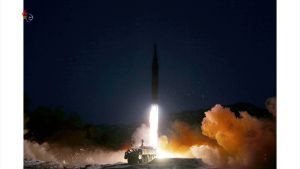Implications of the Second Launch of North Korea’s Second “Hypersonic” Missile

North Korea conducted a ballistic missile launch on January 11. According to South Korea’s Joint Chiefs of Staff, the missile “flew more than 700 kilometers at a maximum altitude of 60 km and at a top speed of Mach 10. The missile reportedly was launched from the same location as the “hypersonic missiles” launched in September 2021 and on January 5, 2022.
The next day, North Korea released a statement saying the “final test-fire” of an unnamed “hypersonic missile,” which was watched by Kim Jong Un, released a “hypersonic glide vehicle” that made “jump flight from 600 km area before making a 240 km turning maneuvering from the initial launch azimuth to the target azimuth and hitting the set target in waters 1[,]000 km off.”[1] According to the statement, the test “was aimed at the final verification of overall technical specifications of the developed hypersonic weapon system,” and “the superior maneuverability of the hypersonic glide vehicle was more strikingly verified through the final test-fire.” The statement was accompanied by several photographs showing a launch from a road-mobile launcher of the same type of liquid-propellant ballistic missile and payload first launched on January 5, with Kim observing the launch, and a video display in the background depicting the missile’s path along the lines described in the North Korean statement.[2]
Information to date on the January 11 launch has several implications, factoring in what was learned from the first launch of this unnamed type of “hypersonic missile” on January 5, and from the first (and thus far only) launch of the “Hwasong-8” type of “hypersonic missile” in September 2021. They include:
- The payload on the January missiles is more likely a maneuvering reentry vehicle (MaRV) than a boost-glide vehicle (BGV). The North termed the payload of the January 11 launch a “hypersonic glide vehicle” (aka, boost-glide vehicle [BGV]). But the relatively modest “turning maneuver” depicted on the video display in the North Korean photographs—which seems to match tracking information released by Japan—and the North’s claim that this second launch was the final one in the system’s development are more consistent with the payload being a MaRV. MaRVs are less maneuverable and less technically demanding (thus requiring less flight testing) than a BGV. (Interestingly, the North termed the payload on the September 2021 launch—which was a BGV—a “hypersonic gliding warhead.”[3]) In any case, a BGV, a MaRV, and a traditional reentry vehicle would all be “hypersonic” when launched from a booster of the size used in the January launches.
- The booster is an MRBM. Both the Hwasong-8 and the two January launches use the same or similar booster, which appears to be a shortened version of the Hwasong-12 intermediate-range ballistic missile (IRBM: 3,000-5,500-km range). The January 11 launch’s reported 1,000-km range, 60-km altitude, Mach 10 speed and 240-km maneuver collectively indicate this booster could deliver a traditional reentry vehicle on a typical “minimum energy trajectory” to an even greater range, making it a medium-range ballistic missile (MRBM: 1,000-3,000-km range). It remains to be seen whether the North only uses this booster to deliver specialized payloads like the Hwasong-8 BGV and January 2022 MaRV, or whether it also tests and deploys it with a traditional reentry vehicle to augment or replace its older Nodong and Hwasong-9 Extended-Range Scud MRBMs. The new booster’s use of more energetic, storable propellants would offer performance and operational advantages over the older systems.
- The system’s developmental status remains unclear. The North has termed development of the new system to be complete. North Korea traditionally develops and deploys missiles after fewer flight tests than the US, USSR/Russia and China employ. By Pyongyang’s standards, the booster of the new missile, which was apparently successful in both January launches as well as in the September 2021 Hwasong-8 launch, probably is “deployable.” Regarding the payload, as noted above, it is more likely that a MaRV (which the North has experience with on the KN-18 Scud variant) could complete development after two flight tests than a BGV. It remains to be seen if there are further launches of the January 2022 missile (whether North Korea calls them “flight tests” or not) and if the system actually is deployed.
What about the Hwasong-8? We do not know what, if anything, the proclamation that the January 2022 system has completed development (not to mention the description of its payload as a “hypersonic glide vehicle”) means for the Hwasong-8 program. It remains to be seen whether the Hwasong-8 will fall by the wayside in favor of the January 2022 missile or whether Hwasong-8 tests will continue, and if so, whether the Hwasong-8 will be pursued in competition with the January 2022 system or in parallel to fulfill a different role.
- [1]
[1] “Distinguished Feat of WPK in History of Leading Juche-based Defence Industry Success in Another Hypersonic Missile Test-fire Respected Comrade Kim Jong Un Watches Test-fire in Field,” Rodong Sinmun, January 12, 2022.
- [2]
- [3]
“Hypersonic Missile Newly Developed by Academy of Defence Science Test-fired,” KCNA, September 29, 2021.
